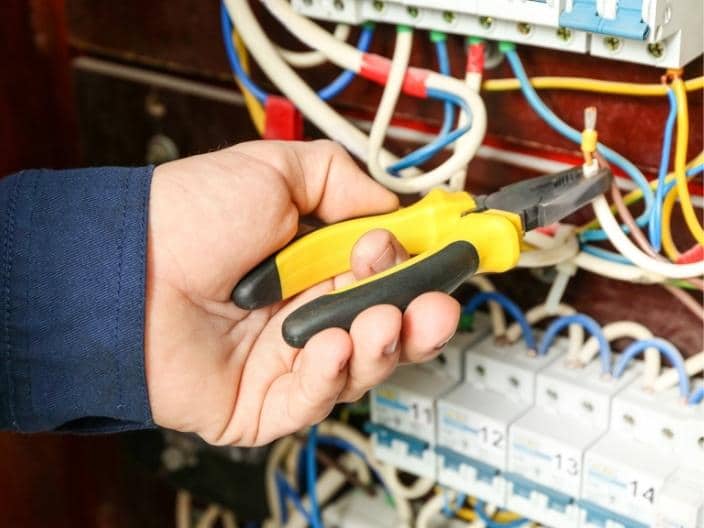Whether you are considering a career as an electrician or you are already an electrician looking to open additional job opportunities, you might consider the role of inside wireman. However, if you are unfamiliar with the term, you might be wondering, “What is an inside wireman?” Luckily, we’re here to help answer that question and a few others that might also come up. The following guide covers a typical inside wireman job description, the difference between a wireman and an electrician, and the unique training requirements for the role.
What Is an Inside Wireman?
An inside wireman is a specialized type of electrician. Unlike an outside lineman, who works on transmission cables, a wireman works inside buildings. His primary role is running inside wiring and connecting equipment to the power grid. However, looking at an inside wireman job description, you may see responsibilities that go far beyond connecting the power supply.
Kind of Work That an Inside Wireman Does
One way to look at it is that an inside wireman does all of the work that a lineman does not. For example, they connect buildings to an external power supply, but that is not all. Inside wiremen also perform all necessary electrical work inside residential or commercial buildings to ensure it is ready to connect the power.
The work of inside wiremen is varied, and they may perform different tasks daily during a project. A few of the more common job responsibilities you might see when exploring what is an inside wireman include:
- Installing Fire Alarm Systems
- Installing and repairing process control systems
- Diagnosing and repairing electrical systems
- Installing interior electrical fixtures
- Distributing power within buildings to equipment like HVAC systems and motors
- Running new wiring and conduit
- Designing power distribution for construction projects
- Arranging for and connecting temporary power for a project
- Connecting electrical service
- Comprehensive project planning
As you can see, the job description is varied and requires a wide range of skills. In addition, an inside wireman must also know how to operate various equipment and tools. Some of the equipment that an inside wireman may find himself working on includes security camera and CCTV systems, HVAC controls, electric door systems, fire alarms, fiber cables, motor control centers, transformers, and switch gears.
Licensing Required To Be an Inside Wireman
Licensing requirements for electricians vary between states, with some local municipalities imposing their own. In most cases, you must be a licensed electrician before becoming a wireman. Some states may require a master electrician license before you can complete tasks like connecting buildings to a power source.
Difference Between Inside Wireman and Electrician
Many wonder if inside wireman is just a different name for electrician, based on regional differences. While it may appear that way at first glance, the two jobs have several differences — both major and minor. Exploring those differences can help you better answer “What is an inside wireman?” to see if it is the right career move for you.
Training and Experience
Let’s start with the most significant difference. An inside wireman is an electrician, but an electrician is not automatically an inside wireman. Since the role requires specialized training, it is often filled by experienced professionals who have been exposed to a range of situations, equipment, and tools. However, training programs can provide you with the knowledge necessary to succeed as a wireman.
Electricians and wiremen usually need to complete an apprenticeship or work as a journeyman before becoming licensed. Our Directory of Electrical Contractor License Requirements by State provides additional information about the licensing process. In addition, some states may require you to hold a master electrician license before becoming an inside lineman.
In both roles, you will need to know all local and state building and electrical codes, the National Electric Code, and basic job site safety and first aid. Wiremen must understand other systems to make connections.
Typical Work Duties
There are many areas of overlap in the job duties of electricians and inside wiremen, but there are also differences in the types of work each tradesman performs. For example, both groups perform one of the most common tasks: running wiring in residential buildings. Since all new systems require direct connections, this skill is very practical.
Common Electrician Tasks
Residential electricians perform many tasks. Some include installing receptacles and electrical fixtures, connecting appliances to the power supply, and running wiring for existing buildings or new construction.
Common Wireman Tasks
As we’ve already covered, inside wiremen perform connection between buildings and an external power supply. They also often run fiber cables, electrical wiring, and fire alarm systems and connect HVAC or other mechanical systems to power supplies.
Average Salary
If you are asking “What is an inside wireman?” as part of a career search, then you probably want to know more about average salaries for the position. Of course, like with any other skilled trade, rates will vary between locations and depending on skill and experience level. Additionally, independent electricians and wiremen may earn very different salaries than those employed by major corporations. However, looking at some averages can help you get a rough idea of salary expectations.
According to the Bureau of Labor Statistics, the average salary for electricians in the U.S. is just under $60,400. More experienced electricians are likely to earn more than those just starting. The local cost of living can also affect salary expectations.
The BLS does not differentiate between electricians and inside wiremen for salary estimates. However, data from Indeed suggests that you can expect to earn an average base salary of $49,367 in this role. This does not include overtime or shift premiums, so it is difficult to compare the figures. For example, the site also reports that some union wiremen can expect to earn closer to $75,000 per year.
Wrapping It Up
You will notice some similarities and differences when comparing the responsibilities of an inside wireman vs electrician. While all wiremen are electricians, the role requires a specialized skill set than is usually gained through years of experience as a residential electrician. Salaries are similar for both positions, so choosing the one you prefer is advisable when selecting a career path.

